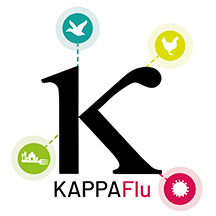Background
The dynamics of highly pathogenic avian influenza (HPAI) viruses of the H5 subtype have changed dramatically in recent years, with record numbers of HPAI H5N1 clade 2.3.3.4b outbreaks in European poultry holdings [1], virus introduction into North America via Iceland, the novel persistence in Europe over the summer season, devastating outbreaks in colony breeding seabirds and increasing numbers of affected terrestrial and marine carnivores. HPAI H5N1 viruses therefore constitutes a massive threat to global poultry production, compromising food security, but also affecting animal welfare, wildlife conservation and human health. The viruses evolve and diversify rapidly, expanding in geographical spread and host range. The dynamic interplay between viruses and their hosts has resulted in a wide spectrum of disease ranging from subclinical infections to mass mortality events in wild bird species, occasionally linked to fatalities in mammals (e.g., seals, foxes, otters), with an unprecedented and ever-increasing negative impact on the agro-ecosystem. The massive numbers of dead birds in the 2020-2021 winter season with 22 million birds killed across 1,247 holdings and 2,243 HPAI detections in dead wild birds in 28 European countries has been surpassed in the 2021-2022 season with 46 million culled birds, 2,398 outbreaks in poultry and 2,733 HPAI detections in wild birds across 36 European countries recorded up until June 2022, with frequent detections ongoing into August. Globally, the incursion in North America resulted in rapid dissemination within the USA and transmission to numerous poultry farms resulting in more than 40 million dead or culled birds in the last months. Further, recent reports of zoonotic events involving HPAI H5 viruses in Russia, Nigeria, the UK, and the USA, along with increasing numbers of human cases with more distantly related H5N6 HPAI viruses in China signal potentially increasing zoonotic risks.
Since 2014, the clade 2.3.4.4 HPAI H5 viruses of the goose/Guangdong (GsGd) lineage have dominated epizootics each year, with clade 2.3.4.4b emerging globally as a particularly invasive virus, likely due to reassortment with low pathogenic avian influenza (LPAI) viruses in wild birds. The epidemiology of HPAI H5 viruses since autumn 2020 has three new concerning features:
- the virus has become enzootic in resident European wild birds;
- the seasonal infection peak has shifted and widened the risk window during both autumn and spring migratory periods;
- the virus was detected across a broader range of species.
Furthermore, the subtype H5N1 now clearly dominates the outbreak situation and is further persisting into the summer season of 2022.
The poor predictability of the continual and highly successful evolutionary changes of HPAI H5 viruses and the fluctuations in host population densities, potentially in relation to climatic and environmental changes, call for an in-depth analysis of this dynamic situation and the resulting options for surveillance and risk mitigation. Furthermore, the dramatically increased incursion pressure makes it necessary to analyse all countermeasure
options, including vaccination as a possible prevention tool.

